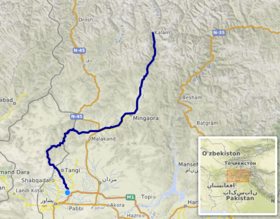The Swat River (Urdu: دریائے سوات, Pashto: سوات سیند) is a perennial river in the northern region of the Khyber-Pakhtunkhwa Province of Pakistan. The river's source is in the high glacial valleys of the Hindu Kush mountains, where it then flows into the Kalam Valley before forming the spine of the wider Swat Valley.
| Swat River سوات | |
|---|---|
 | |
 Course of the Swat (interactive map) | |
| Location | |
| Country | |
| Province | |
| District | Swat |
| Physical characteristics | |
| Source | Hindu Kush Mountains |
| Source confluence | Usho and Gabral rivers |
| • location | Kalam |
| Mouth | Kabul River |
• location | Charsadda |
| Length | 240 km (150 mi) |
| Basin size | 13,000 km2 (5,000 sq mi) |
| Discharge | |
| • location | Munda |
| • average | 280 cubic m/s |
| Basin features | |
| Tributaries | |
| • left | Ushu Khwar, Bashigram Khwar |
| • right | Daral Khwar, Gabral Khwar |
Name
editThe word Swat is a Sanskrit name which may[ambiguous] mean "clear blue water."[1] Another theory derives the word Swat from the Sanskrit word shveta (lit. 'white'), also used to describe the clear water of the Swat River.[2] To the ancient Greeks, the river was known as the Soastus.[3][4][5][2] The Chinese pilgrim Faxian referred to Swat as the Su-ho-to.[6]
Course
editThe Swat's source lies in the Hindu Kush mountains, from where it is fed by glacial waters throughout the year. From the high valleys of Swat Kohistan, the river begins at the confluence of the Usho, and Gabral rivers (also known as the Utrar River) at Kalam. From the confluence, the Swat river flows through the narrow gorges of the Kalam Valley until the city of Madyan. From there, the river courses gently for 160 km (99 mi) through the plain areas of the lower Swat Valley until Chakdara. In the extreme southern end of the Swat valley, the river enters a narrow gorge and joins the Panjkora River, at Qalangi before entering the Peshawar Valley. It finally terminates in Kabul River, near Charsadda.
Discharge
editThe average discharge at Munda is 280 cubic metres (9,900 cu ft) per second.[7]
Economic impact
editSwat River plays an important role in the economy of the valley. Lower reaches of the Swat and Malakand Valley are irrigated by a series of canals regulated by the Amandara Headworks - built by the British in 1903.[8]
The Upper Swat Canal flows under the Malakand Pass through Benton Tunnel, completed in 1914. Below Dargai, the Munda Headworks, built by the British in 1921,[9] feed canals that supply numerous smaller canals in the districts of Charsadda, Swabi and Mardan in the Peshawar Valley. The river also recharges water wells and springs through seepage.
Hydropower
editSwat's waters are used for hydropower generation at the Jabban Hydropower Plant (completed in 1938), and Dargai Hydropower Plant (completed in 1952). The Mohmand Dam, at the lower end of the Swat River's course before it enters into the Peshawar valley, has an installed generation capacity of 740 MW and is under construction.[10] Proposed hydropower projects along the river's course are Asrit Kedam HPP,[11] Gabral HPP[12] and Matiltan HPP.[13]
Gallery
edit-
Upper reaches of the Swat River in the Kalam Valley
-
The town of Bahrain, built along the river
-
Lower reaches of the Swat River valley
-
The Amluk-Dara stupa, one of many ancient Buddhist sites scattered throughout the river's valley
See also
editReferences
edit- Book: Hidden Treasures of Swat, ISBN 978-969-23042-0-7
- ^ Susan Whitfield (2018). Silk, Slaves, and Stupas: Material Culture of the Silk Road. University of California Press. p. 136. ISBN 978-0-520-95766-4.
- ^ a b Sultan-i-Rome (2008). Swat State (1915–1969) from Genesis to Merger: An Analysis of Political, Administrative, Socio-political, and Economic Development. Oxford University Press. p. 13. ISBN 978-0-19-547113-7.
- ^ Edward Herbert Bunbury (1879). A history of ancient geography among the Greeks and Romans. J. Murray.
- ^ Arrian (14 February 2013). Alexander the Great: The Anabasis and the Indica. OUP Oxford. ISBN 978-0-19-958724-7.
- ^ Saxena, Savitri (1995). Geographical Survey of the Purāṇas: The Purāṇas, a Geographical Survey. Nag Publishers. ISBN 978-81-7081-333-0.
- ^ Rienjang, Wannaporn; Stewart, Peter (15 March 2019). The Geography of Gandhāran Art: Proceedings of the Second International Workshop of the Gandhāra Connections Project, University of Oxford, 22nd-23rd March, 2018. Archaeopress. ISBN 978-1-78969-187-0.
- ^ "Feasibility study on the development of Munda Dam multipurpose project in Islamic Republic of Pakist an : final report; Vol. 3. -Supporting report" (PDF). Japan International Cooperation Agency : Nippon Koei Co., Ltd. : Nippon Giken Inc. Archived (PDF) from the original on 7 October 2022.
- ^ "History". www.wapda.gov.pk. Retrieved 22 April 2021.
- ^ Report, Bureau (28 August 2010). "Munda Headworks restored in record time". DAWN.COM. Retrieved 22 April 2021.
{{cite web}}:|first=has generic name (help) - ^ [1][dead link]
- ^ "Korean companies asked to undertake $1.6bn of hydroelectric schemes in Pakistan". Global Construction Review. 8 January 2021. Retrieved 7 October 2021.
- ^ "Pre-qualification bids sought for E&M supply for Gabral Kalam, Pakistan … | Hydropower & Dams International". www.hydropower-dams.com. Retrieved 7 October 2021.
- ^ Poindexter, Gregory (5 December 2016). "Pakistan begins construction of the 84-MW Matiltan hydropower project". Hydro Review. Retrieved 7 October 2021.